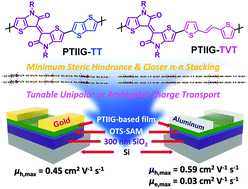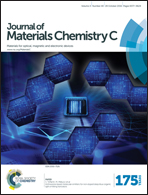Ultra-narrow-bandgap thienoisoindigo polymers: structure–property correlations in field-effect transistors†
Abstract
From a structural point of view, the newly conceived thienoisoindigo (TIIG) moiety can serve as an ideal building block for the synthesis of high-performance polymers. To expand the range of available TIIG-based conjugated polymers, herein we report the synthesis and characterization of two new TIIG-based donor–acceptor polymers (PTIIG-TT and PTIIG-TVT), containing either the thieno[3,2-b]thiophene (TT) or the (E)-2-(2-(thiophen-2-yl)vinyl)thiophene (TVT) moiety. In addition, we conducted a systematic investigation on the relationship between the microstructure of the polymer film and charge transport in organic field-effect transistors (OFETs) fabricated using these polymers. It was observed that the incorporation of a TVT moiety into the TIIG backbone imparts higher crystallinity and increases the molecular packing density, leading to an increased hole mobility (∼0.45 cm2 V−1 s−1) in PTIIG-TVT, compared with PTIIG-TT. When an Al electrode is used instead of a Au electrode in the OFET devices, both polymers exhibit outstanding ambipolar characteristics. This study advances the understanding of the structural features of TIIG-based polymers, which will potentially accelerate the improvement in the mobility of TIIG-based polymers.


 Please wait while we load your content...
Please wait while we load your content...